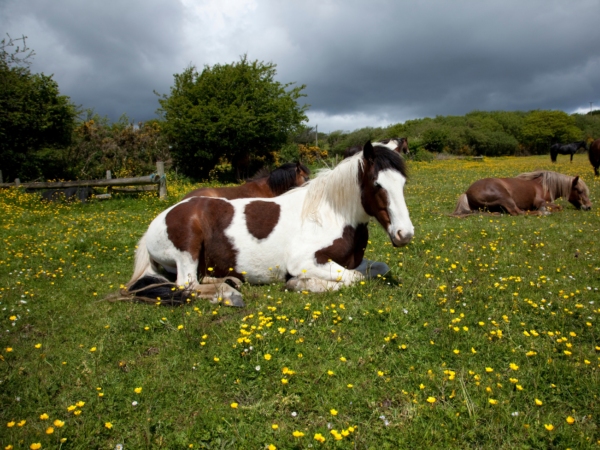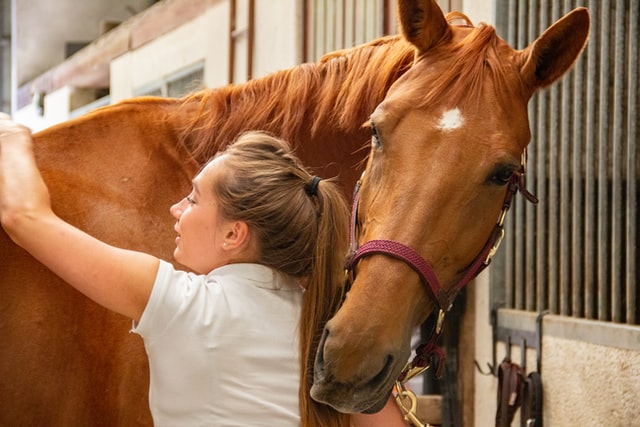The Ultimate Guide to Blanketing Horses
Fall and Winter mean cold and wet weather.
There is a lot of confusion and different advice out there about blanketing horses so we’ve written this ultimate guide!

Each season creates their own horse keeping challenges.
Fall and Winter mean the days are getting shorter, the temperatures are getting colder and rain, snow and sleet are all things we have to contend with.
Blanketing Horses – Does Your Horse Actually Need a Blanket?
Cold weather and temperature changes may be the best time to use horse blankets, but other factors and situations should be taken into consideration.
Horses, however, are naturally designed to live outdoors in all kinds of weather.
In fact, the ancient relative of the horse adapted and survived the Ice Age, so they may not need as much help staying warm in the Winter as we think.
In response to the shorter days, your horse will begin to grow his Winter coat, a thicker and longer fur that stands upright instead of laying against his skin.
This traps air and acts as insulation.
In addition to a new Winter coat, your horse’s digestion help warm him from the inside out.
The fermentation that your horse’s gut does generates heat, so in addition to a blanket and adequate shelter, making sure your horse has free choice roughage all Winter long can help keep him warm.
The truth is that most horses, in most conditions don’t need blankets.
With thick fur and the body’s natural temperature regulator, some of these horses can withstand extreme weather conditions.
The following are situations that your horses may need a blanket for:
Blanketing the Young or Old Horse
Very young horses still have immature organs and body parts, so they may not be capable yet of adapting to sudden weather changes.
Some may still have thin fur that are not yet capable of acting as insulator.
On the other hand, too old horses may lack sufficient energy and fat to keep their body warm.
If you have an older horse or one that struggles to keep weight on, you may want them to conserve their calories and not shiver to keep warm.
Blanketing Your Horse With Wet Fur
Thick fur can act as insulation against cold and wind.
But when it’s wet, it doesn’t trap the air well and won’t insulate the horse as well as a dry fluffy coat.
It can be difficult to know when to blanket, but if there’s going to be rain during the day and freezing temperatures at night, I would recommend blanketing.

The Parts of Horse Blankets
Blanketing Horses – Tail flap
The tail flap is just how it sounds – a flap of blanket, either permanent or removable, that covers the top of the horse’s tail.
It prevents cold rain from dripping down between the horse’s hindlegs.
Leg straps
Leg straps go down and around each hind leg, helping to keep the blanket in place.
Some blankets, instead of having two legs straps that go down and around, they’ll have one butt strap that simply connects both sides of the blanket under the tail.
Leg straps are usually nylon or elastic and adjustable.
Surcingles
The surcingles on a horse blanket are the straps that go underneath the horse’s body to secure both sides of the blanket.
Blankets can have either one, two or three surcingles.
Shoulder gussets
It is possible for horses to feel uncomfortable with blankets because they may limit their movement.
Shoulder gussets are extra flaps of blanket material and provide more room for the horse’s shoulder and front leg movement.
Front closures
The front closures on a blanket secure the two sides of the blanket together with buckles or clips.
Hoods and neck covers
It is always best to choose a horse blanket that can provide optimum coverage from cold winds for your horses’ neck and hoods.
This doesn’t only keep your horses warm but also covers the coat and mane to keep it smooth, sleek, and healthy throughout the year.
But not all types of blankets are created equal.
As a matter of fact, some of these blankets may cause more harm than good, so knowing what blanket to use and when is vital.
Different Types of Horse Blankets
So if you have decided to purchase horse blankets for your horse, then it’s best to know and understand the different types of horse blankets available.
By knowing each type, you will be prepared before the season begins.
Here are the four types:
Rain Sheet
If your horse struggles with rain rot (see my entire post here on what rain rot is and how to prevent and treat it) or you’d like an extra layer of water-proofing, look at investing into a rain sheet.
Rain sheets are thin and not designed for keeping a horse warm and insulated, however they can be thrown on top of a other blankets for an added layer.
Turnout Blanket
This type is made of waterproof, rugged material and are usually categorized as light-weight, medium-weight or heavy-weight.
These just refer to the amount of stuffing material and subsequent insulating ability.
Designed to keep your horses warm during the cold seasons, most horse owners find this type a good investment, especially when there’s sudden changes in the temperature.
Cooler
Coolers are designed to keep your horse warm after or during a workout.
To prevent sweating and sudden chills, or simply drastic changes in temperature, they prevent your horse’s sweat from cooling too quickly causing chills.
Coolers are typically made from two materials: wool and fleece.
Most experts suggest the wool due to its ability to draw moisture from your horse’s coat.
They do not have any water-proofing, so do not turn your horse out in one.
They also make quarter-coolers that cover a horse’s back end while allowing room for a saddle so that you can keep your horse warm while exercising.
Stable Blanket
This is one of the best horse blankets for horses in the barn.
Similar to a cooler, stable blankets are not water-proof and not meant for turnout, however they still come in varying weights: light-, medium- and heavy-.
If you’re not sure which blanket is right for you, Equivania has a super useful sliding scale that can help you find the perfect blanket for your horse!
Blanketing Your Horse
While putting on a horse blanket seems pretty obvious, there are techniques for doing so that ensure you and your horse’s safety. Here are the steps:
- With your horse secure, approach his left side (the side you mount from) and lay the blanket outside-down across your thighs.
- Grab the shoulder areas on blanket and gently toss the blanket over your horse’s back.
- Adjust it so that it is evenly placed on your horse’s back.
- Secure the chest strap(s) first so that if your horse spooks or gets loose the blanket will remain secure instead of falling and wrapping around his legs.
- Then attach the leg straps. If your blanket has two elastic straps at the back, you’ll attach the left strap around the left leg and back to the left side of the blanket. The right strap will go from the right back of the blanket, loop it through the left strap, and then back around to the right side of the blanket.
- Reach under the horse’s belly for the surcingle pull it towards you and then buckle. If your blanket has multiple surcingles, take a look at the buckle straps for a clue as to how to connect them. Some two-surcingle blanket will have the straps cross each other, so the buckle straps will be at an angle.

